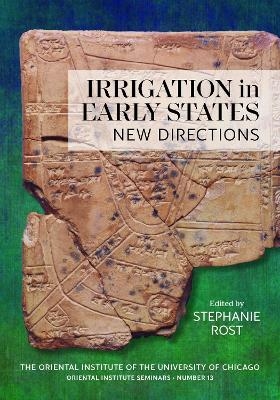
Irrigation in Early States
New Directions
Seiten
2022
Institute for the Study of Ancient Cultures (Verlag)
978-1-61491-071-8 (ISBN)
Institute for the Study of Ancient Cultures (Verlag)
978-1-61491-071-8 (ISBN)
The cross-cultural studies in this volume reexamine the role of irrigation in early states. Ranging from South America and the southwestern United States to North Africa, the Middle East and Asia they describe the physical attributes and environments of early irrigation systems and irrigation's economic, sociopolitical and cosmological dimensions.
The cross-cultural studies in this volume reexamine the role of irrigation in early states. Ranging geographically from South America and the southwestern United States to North Africa, the Middle East and Asia, they describe the physical attributes and environments of early irrigation systems; various methods for empirical investigation of ancient irrigation; and irrigation's economic, sociopolitical and cosmological dimensions. Through their interdisciplinary perspectives, the authors--all experts in the field of irrigation studies--advance both methodological and theoretical approaches to understanding irrigation in early civilizations.
Irrigation has long been of interest in the study of the past. Many early civilizations were located in river valleys, and irrigation was of great economic importance for many early states because of the key role it played in producing an agricultural surplus, which was the main source of wealth and the basis of political power for the elites who controlled it. Agricultural surplus was also necessary to maintain the very features of statehood, such as urbanism, full-time labour specialization, state institutions and status hierarchy.
Yet the presence of large-scale or complex irrigation systems does not necessarily mean that they were under centralised control. While some early states organised the construction, operation and maintenance of irrigation works and resolved conflicts related to water distribution, other early governments left most of the management to local farmers and controlled only the surplus.
With colour illustrations
The cross-cultural studies in this volume reexamine the role of irrigation in early states. Ranging geographically from South America and the southwestern United States to North Africa, the Middle East and Asia, they describe the physical attributes and environments of early irrigation systems; various methods for empirical investigation of ancient irrigation; and irrigation's economic, sociopolitical and cosmological dimensions. Through their interdisciplinary perspectives, the authors--all experts in the field of irrigation studies--advance both methodological and theoretical approaches to understanding irrigation in early civilizations.
Irrigation has long been of interest in the study of the past. Many early civilizations were located in river valleys, and irrigation was of great economic importance for many early states because of the key role it played in producing an agricultural surplus, which was the main source of wealth and the basis of political power for the elites who controlled it. Agricultural surplus was also necessary to maintain the very features of statehood, such as urbanism, full-time labour specialization, state institutions and status hierarchy.
Yet the presence of large-scale or complex irrigation systems does not necessarily mean that they were under centralised control. While some early states organised the construction, operation and maintenance of irrigation works and resolved conflicts related to water distribution, other early governments left most of the management to local farmers and controlled only the surplus.
With colour illustrations
Stephanie Rost is an assistant professor in the History Department at Queensborough Community College of the City University of New York. She was the organizer of the Oriental Institute postdoctoral fellow seminar "Irrigation in Early States: New Directions."
| Erscheinungsdatum | 25.07.2022 |
|---|---|
| Reihe/Serie | ISAC Seminars |
| Zusatzinfo | 99 figs (some in colour), 45 tbls & 4 maps |
| Sprache | englisch |
| Maße | 179 x 252 mm |
| Gewicht | 1137 g |
| Themenwelt | Geschichte ► Allgemeine Geschichte ► Vor- und Frühgeschichte |
| Geschichte ► Allgemeine Geschichte ► Altertum / Antike | |
| Geschichte ► Teilgebiete der Geschichte ► Kulturgeschichte | |
| Sozialwissenschaften ► Ethnologie | |
| Sozialwissenschaften ► Soziologie | |
| Weitere Fachgebiete ► Land- / Forstwirtschaft / Fischerei | |
| ISBN-10 | 1-61491-071-5 / 1614910715 |
| ISBN-13 | 978-1-61491-071-8 / 9781614910718 |
| Zustand | Neuware |
| Informationen gemäß Produktsicherheitsverordnung (GPSR) | |
| Haben Sie eine Frage zum Produkt? |
Mehr entdecken
aus dem Bereich
aus dem Bereich
Was Pompeji über uns erzählt
Buch | Hardcover (2023)
Propyläen (Verlag)
CHF 44,75
auf den Spuren der frühen Zivilisationen
Buch | Hardcover (2023)
C.H.Beck (Verlag)
CHF 27,95


